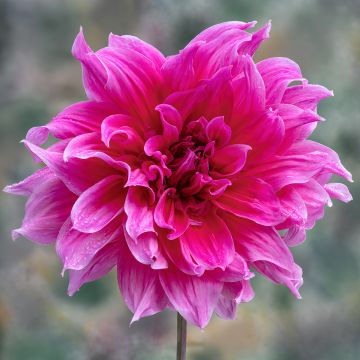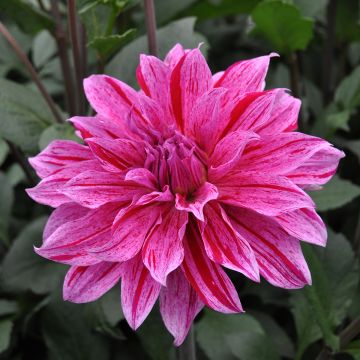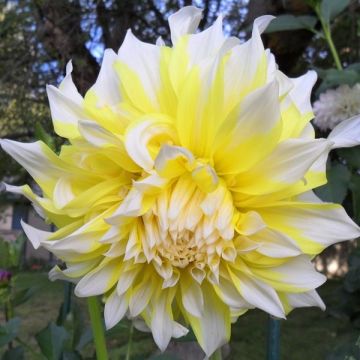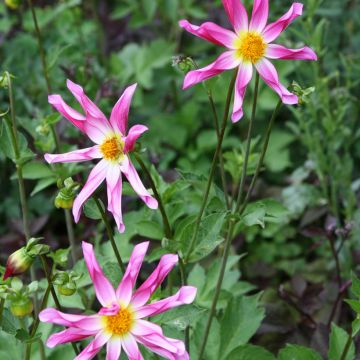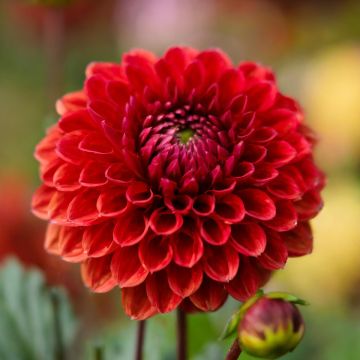

Dahlia imperialis - Giant Dahlia


Dahlia imperialis - Giant Dahlia


Dahlia imperialis - Giant Dahlia


Dahlia imperialis - Giant Dahlia


Dahlia imperialis - Giant Dahlia
Dahlia imperialis - Giant Dahlia
Dahlia imperialis
Tree Dahlia, Giant Dahlia
Unfortunately, a second unsuccessful attempt to see this beautiful plant that I discovered in Italy grow and flourish. After planting 4 to 5 bulbs in different places twice, I have a small shoot and nothing else. I am far from the magnificent plant that blooms in autumn. I am hesitant to make a third and final attempt!
Bruno , 27/07/2024
Why not try an alternative variety in stock?
View all →This plant carries a 6 months recovery warranty
More information
We guarantee the quality of our plants for a full growing cycle, and will replace at our expense any plant that fails to recover under normal climatic and planting conditions.
From €5.90 for pickup delivery and €6.90 for home delivery
Express home delivery from €8.90.
Does this plant fit my garden?
Set up your Plantfit profile →
Description
The Dahlia Imperialis is the giant of the genus, with its tree-like habit that can reach a height of 4 metres (13 feet) under good conditions. This botanical species impresses with its bamboo-like appearance and lush growth and charms with its beautiful autumn flowering when not destroyed by frost or wind. At the top of this lovely plant, large panicles of flowers in wide and unpretentious heads bloom, which can be admired from below: around a beautiful yellow-orange centre, pretty pale pink scarves are arranged, slightly crumpled.
The Dahlia imperialis belongs to the large botanical family of Asteraceae, just like our garden dahlias. It is native to Central America's high plateaus and mountains, from Mexico to Guatemala, where it is found at altitudes between 1500 and 1700 m (4921 and 5577ft). It is a herbaceous plant with semi-woody stems, perennial due to its large tuber and artichoke-like taste. Its cold resistance is quite limited; its roots are destroyed below -5°C. With a thick protective mulch planted in a warm and dry location, this dahlia will survive short periods of freezing temperatures around -8°C.
Depending on the region, this tree-like dahlia starts late in spring, more or less early. But its rapid growth can reach 2 to 4 m (7 to 13ft) in height with a spread of 1 to 1.50 m (3 to 5ft) in a few months. From the ground emerge powerful, hollow, and green-coloured herbaceous stems with a circumference of 8 to 10 cm (3 to 4in). Prominent rings, similar to bamboo canes, mark them. Each stem branches out. It bears large leaves divided into seven ovate and dentate leaflets, carried by purple petioles. Their colour is deep green on the upper side and more glaucous on the lower side. A decrease in day length induces flowering. It usually occurs in October-November or even as early as September, depending on the climate. At the tips of the stems, 30 to 35 flowers bloom, organized in heads on a mature plant. Each head measures 10 to 13 cm (4 to 5in) in diameter. Slightly inclined, somewhat campanulate, and not fully open, their style resembles single-flowered decorative dahlias. The central disk of the head is composed of tiny florets in yellow-orange colour. It is surrounded by a collar of ligules, or slightly crumpled 'petals', in pale lavender pink. The first frost will destroy the above-ground vegetation of this dahlia. The plant goes dormant underground in winter.
Extremely decorative, this captivating plant will find its place in a sheltered position from wind and cold, warm and sunny. The Dahlia imperialis deserves a prime location in the garden: in front of a screen of bushes that will cut the wind, near the house's entrance against a protective wall, or even in the corner formed by two facades. It can be associated with plants with exotic charm, such as banana trees or palm trees, giant cannas, or castor oil plants. In a romantic setting, its flowering will accompany late-flowering shrubs, such as Aralia elata, strawberry trees, or autumn camellias.
Report an error about the product description
Dahlia imperialis - Giant Dahlia in pictures


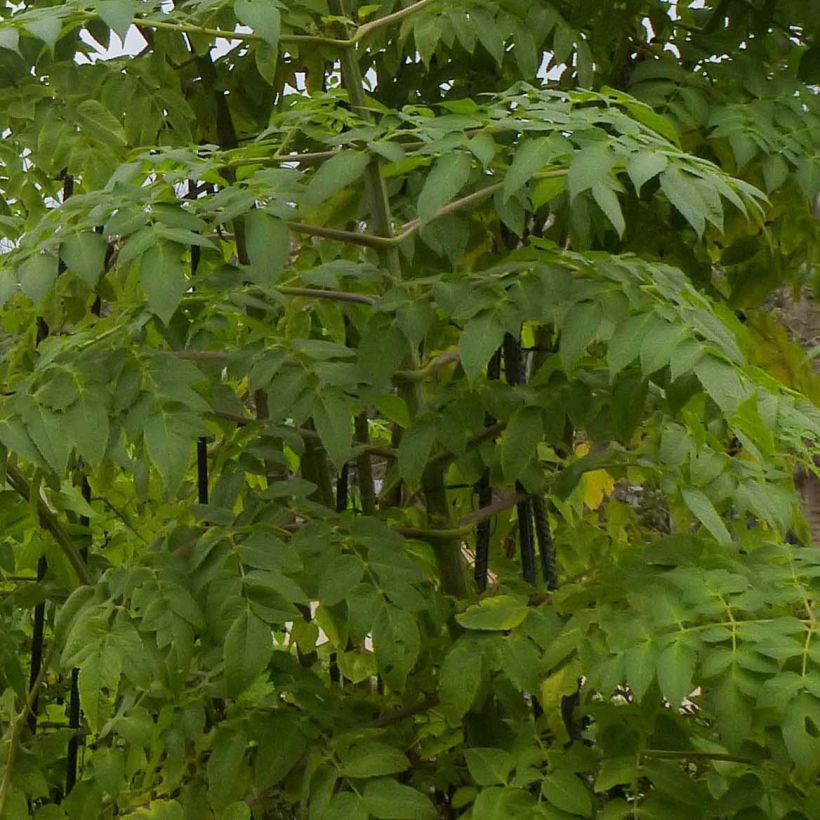

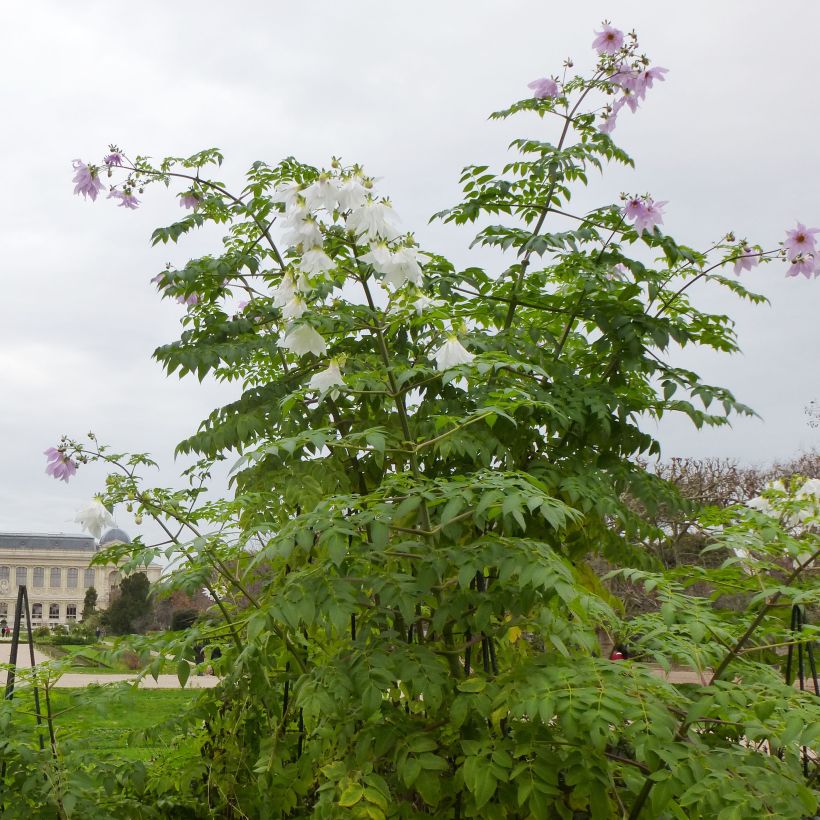

Plant habit
Flowering
Foliage
Botanical data
Dahlia
imperialis
Asteraceae
Tree Dahlia, Giant Dahlia
Central America
Other Giant Dahlia
Planting and care
Plant your Imperialis dahlias in the spring in deeply tilled and enriched soil, for example with blood, fish and bone. Place your tubercle and crumble the soil well to fill without air pockets. Your dahlia should be covered with 6 cm (2in) of soil. At the end of planting, pour one liter of water. Water regularly during the first 6 weeks to help with rooting. Water regularly in case of dry summers. In mild regions, the tubercle can stay in the ground during the winter, provided that the stump is protected from cold and humidity with a thick mulch. Cut the large stems with a saw once the vegetation has been destroyed by the cold, leaving 30 cm (12in) protruding from the ground.
Dahlias are sensitive to cold, they need to be overwintered. In November, the first frost will blacken the foliage, that's when you should dig them up. Carefully remove the tubercles. Remove as much soil as possible. Let the foliage dry, so that the tubercle can replenish its reserves. When the foliage is dry, cut the stems 10 cm (4in) from the tubercle. Spread your bulbs in a crate on a newspaper. Store away from frost in a dry, cool, and dark place.
Planting period
Intended location
Care
-
, onOrder confirmed
Reply from on Promesse de fleurs
Dahlias
Haven't found what you were looking for?
Hardiness is the lowest winter temperature a plant can endure without suffering serious damage or even dying. However, hardiness is affected by location (a sheltered area, such as a patio), protection (winter cover) and soil type (hardiness is improved by well-drained soil).

Photo Sharing Terms & Conditions
In order to encourage gardeners to interact and share their experiences, Promesse de fleurs offers various media enabling content to be uploaded onto its Site - in particular via the ‘Photo sharing’ module.
The User agrees to refrain from:
- Posting any content that is illegal, prejudicial, insulting, racist, inciteful to hatred, revisionist, contrary to public decency, that infringes on privacy or on the privacy rights of third parties, in particular the publicity rights of persons and goods, intellectual property rights, or the right to privacy.
- Submitting content on behalf of a third party;
- Impersonate the identity of a third party and/or publish any personal information about a third party;
In general, the User undertakes to refrain from any unethical behaviour.
All Content (in particular text, comments, files, images, photos, videos, creative works, etc.), which may be subject to property or intellectual property rights, image or other private rights, shall remain the property of the User, subject to the limited rights granted by the terms of the licence granted by Promesse de fleurs as stated below. Users are at liberty to publish or not to publish such Content on the Site, notably via the ‘Photo Sharing’ facility, and accept that this Content shall be made public and freely accessible, notably on the Internet.
Users further acknowledge, undertake to have ,and guarantee that they hold all necessary rights and permissions to publish such material on the Site, in particular with regard to the legislation in force pertaining to any privacy, property, intellectual property, image, or contractual rights, or rights of any other nature. By publishing such Content on the Site, Users acknowledge accepting full liability as publishers of the Content within the meaning of the law, and grant Promesse de fleurs, free of charge, an inclusive, worldwide licence for the said Content for the entire duration of its publication, including all reproduction, representation, up/downloading, displaying, performing, transmission, and storage rights.
Users also grant permission for their name to be linked to the Content and accept that this link may not always be made available.
By engaging in posting material, Users consent to their Content becoming automatically accessible on the Internet, in particular on other sites and/or blogs and/or web pages of the Promesse de fleurs site, including in particular social pages and the Promesse de fleurs catalogue.
Users may secure the removal of entrusted content free of charge by issuing a simple request via our contact form.
The flowering period indicated on our website applies to countries and regions located in USDA zone 8 (France, the United Kingdom, Ireland, the Netherlands, etc.)
It will vary according to where you live:
- In zones 9 to 10 (Italy, Spain, Greece, etc.), flowering will occur about 2 to 4 weeks earlier.
- In zones 6 to 7 (Germany, Poland, Slovenia, and lower mountainous regions), flowering will be delayed by 2 to 3 weeks.
- In zone 5 (Central Europe, Scandinavia), blooming will be delayed by 3 to 5 weeks.
In temperate climates, pruning of spring-flowering shrubs (forsythia, spireas, etc.) should be done just after flowering.
Pruning of summer-flowering shrubs (Indian Lilac, Perovskia, etc.) can be done in winter or spring.
In cold regions as well as with frost-sensitive plants, avoid pruning too early when severe frosts may still occur.
The planting period indicated on our website applies to countries and regions located in USDA zone 8 (France, United Kingdom, Ireland, Netherlands).
It will vary according to where you live:
- In Mediterranean zones (Marseille, Madrid, Milan, etc.), autumn and winter are the best planting periods.
- In continental zones (Strasbourg, Munich, Vienna, etc.), delay planting by 2 to 3 weeks in spring and bring it forward by 2 to 4 weeks in autumn.
- In mountainous regions (the Alps, Pyrenees, Carpathians, etc.), it is best to plant in late spring (May-June) or late summer (August-September).
The harvesting period indicated on our website applies to countries and regions in USDA zone 8 (France, England, Ireland, the Netherlands).
In colder areas (Scandinavia, Poland, Austria...) fruit and vegetable harvests are likely to be delayed by 3-4 weeks.
In warmer areas (Italy, Spain, Greece, etc.), harvesting will probably take place earlier, depending on weather conditions.
The sowing periods indicated on our website apply to countries and regions within USDA Zone 8 (France, UK, Ireland, Netherlands).
In colder areas (Scandinavia, Poland, Austria...), delay any outdoor sowing by 3-4 weeks, or sow under glass.
In warmer climes (Italy, Spain, Greece, etc.), bring outdoor sowing forward by a few weeks.

































